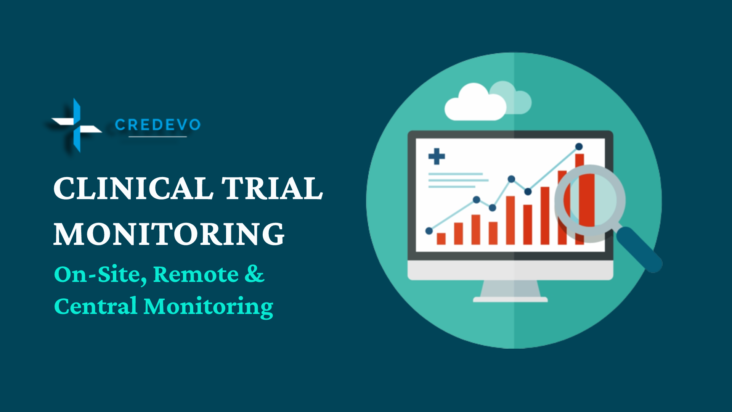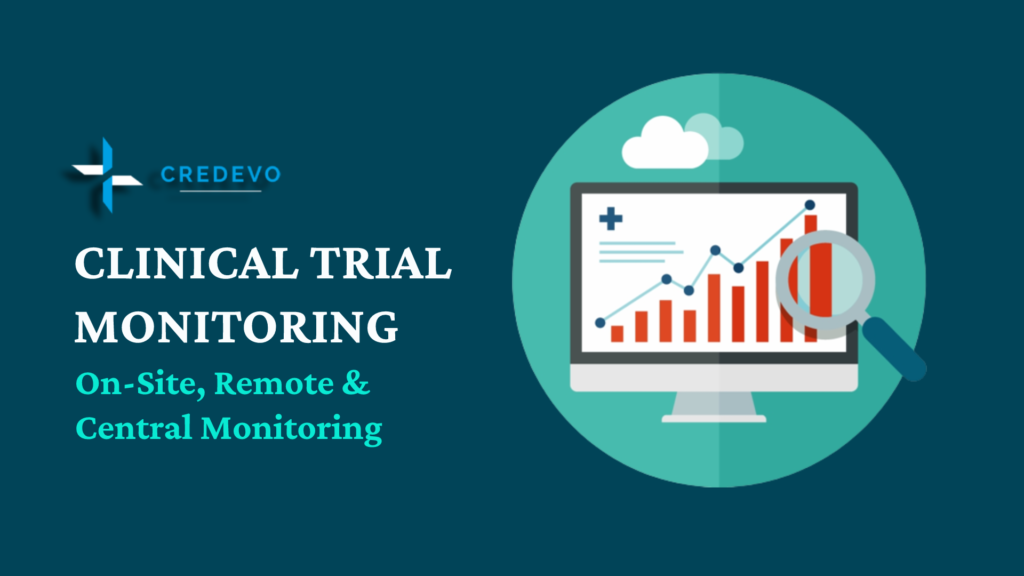Clinical Trial Monitoring: On-Site, Remote & Centralized Monitoring

The protection of human rights is paramount in clinical trials, and one should design and implement clinical research ethically and scientifically. Clinical trial monitoring is essential for quality assurance to ensure the protection of human rights and the reliability and transparency of the data collection process.

What is clinical trial monitoring?
Clinical trial monitoring is the act of overseeing the progress of a clinical trial and ensuring that they are conducted, recorded, and reported in accordance with the protocol, Standard Operating Procedure (SOPs), The Principles of Good Clinical Practice (GCP), and the medicines for human use regulations wherever applicable.
Why do you need to monitor your clinical trials?
- Ensures to protect the rights of participants.
- It helps to check data accuracy and verify data from source documents.
- Ensures that the clinical trials comply with GCP and other regulatory requirements.
According to the U.S. Food and Drug Administration’s Center for Drug Evaluation and Research, the top five failures caught by clinical monitors are
- Follow investigation protocol (the procedures and treatment subjects must undergo, as well as the schedule of assessments)
- Failure to keep adequate and accurate records
- Problems with the informed consent form
- Failure to report adverse events
- Failure to account for the disposition of study drugs
In clinical monitoring, a clinical monitor observes whether they follow standardized operation procedures and reports and manages any deviations from the investigation plan as they occur.
Also, the International Conference on Harmonization of technical requirements for Registration of Pharmaceuticals for human use (ICH-GCP) recommends on-site monitoring before, during, and after the trial procedure and advises central monitoring in exceptional circumstances.
Who performs clinical monitoring?
Monitors may be referred to by many different titles, such as
- Clinical Research Associate,
- “on-site” monitor,
- Clinical Research Monitor,
- Study Site Monitor and
- Quality Specialist.
And all the team members with different job titles perform clinical trial monitoring.
General functions performed during the monitoring
- Monitors check the Informed Consent Forms (ICFs) completeness and ensure that patients sign these forms.
- Verify the patient eligibility criteria and ensure that all subjects are eligible for the trial.
- Promptly reports the adverse events by verifying the source systems and the reports.
- Concerning the source documents verifies the accuracy and completeness of case report forms.
- Checks documentation of the dose and treatment modifications done for any specific patients.
After verification, monitors submit a report after each site visit to the sponsors. These reports include the following
- A detailed summary of review during visits
- Significant findings, if any
- Taken actions and
- Recommendations
What are the different types of monitoring
There are some ways of clinical trial monitoring
- On-site Monitoring
- Remote Monitoring
- Centralized Monitoring
The traditional site monitoring methods are costly, subject to data quality errors, and manual. Sponsors spend about 20% to 30% of the clinical trial cost for monitoring. But, during the COVID pandemic, many sponsors have started adopting modern monitoring techniques. One such monitoring is centralized remote monitoring. It resolves many traditional monitoring issues and is cost-effective. So the monitoring selection depends on several aspects of the clinical trial.
Factors that affect the selection of monitoring type
The level of scrutiny of monitoring varies across studies based on the risks and nature of the trial. Below are some factors that affect monitoring and the monitoring type necessary for clinical trials.
- First and foremost, the factor that affects the complexity of monitoring is the protocol design. These include the duration of treatment, interaction intensity necessary, the requirement of a special population, etc.
- The therapeutic area under evaluation
- The severity of the treatment
- Number of patients involved in the study
- Number of clinical trial sites
- SOPs
- The phase of the clinical trial
The overall monitoring plan should remain fairly consistent, but the strategy for individual sites may change considerably depending on study conditions and site performance.
Let’s discuss each monitoring method in detail.
On-site monitoring
On-site monitoring involves in-person evaluation by sponsor personnel or representatives at the investigation site. It is a traditional method of monitoring and provides many advantages.
- The presence of monitors at the site is necessary for some kinds of trials where remote monitoring is inadequate. In some cases where patient information protection is a priority, monitors shall physically review the documents.
- It helps maintain a more effective relationship with the stakeholders, the investigator, and the sponsor. A good relationship helps monitor, detect, and resolve issues early.
- In physical presence, clinical monitors may provide immediate solutions for a few problems and can actively involve study teams.
- It helps motivate study teams, which in turn helps attain high-quality data and compliance in the study end.
Remote monitoring
Remote monitoring in clinical trials means clinical trial monitors do not visit the site to transfer and review the data. Instead, monitor the data monitoring virtually using digital platforms and applications. CROs and study sponsors/stakeholders supervise the data from their location.
The COVID-19 pandemic has made remote monitoring a necessity for ongoing clinical trials. Remote site access and monitoring platforms have become an essential element of the clinical trial process and created a pivotal connection between the research site, sponsor, and clinical research organization (CRO).
The sponsor or CRO ensures to perform the clinical trial as per the clinical trial protocol, Standard Operating Procedures (SOPs), Good Clinical Practices (GCPs), and other regulatory requirements. Previously sponsored would monitor sites through various communication mediums such as online, fax, email, cloud-based file share systems, and site visits.
FDA recommended using remote monitoring long back in 2013. However, this was not a necessity for the clinical trial industry, but now COVID-19 has accelerated the whole industry sees toward remote monitoring. Here is the guidance for remote access by FDA.
Centralized monitoring
In multi-center clinical trials, centralized monitoring is a good option. It ensures patient safety, trial integrity, and data quality.
The centralized monitoring came into action after the publication of regulatory guidance on risk-based monitoring (RBM). Global regulators recommend centralized monitoring in conjunction with on-site monitoring to oversee clinical trials. Before implementing centralized monitoring, it is critical to understand the concept of risk management.
In centralized monitoring, the central coordinating team identifies and reviews key data at pre-specified time points. The study team can review eligibility criteria, adverse events, and consent forms centrally to assure the trial team the completeness and correctness. The central team can also review the drug accountability logs to ensure the site has sufficient stock, dosing, and enrolment data.
One factor the central monitoring team needs to consider is the internet connection at the site. Poor internet connection may impact timely data upload and review by the study team.
Other than these mentioned monitoring, there are several adopted monitoring techniques such as Safety monitoring, and Risk-based monitoring, Let’s understand them.
Safety monitoring
Safety monitoring is another important aspect of clinical trials. The monitor reviews adverse events and follows up with a timely resolution. Monitoring is performed on a regulator basis. An independent physician with relevant expertise monitors the safety of a clinical trial.
Who conducts the safety monitoring
The monitoring may be conducted by
- sponsor or
- Contract research organization (CRO) staff or
- contractor, and/or
- by the Principal clinical investigator/project manager
However, the overall monitoring activity is the responsibility of the sponsor.
Risk-based monitoring
Risk-based monitoring is an aggressive strategic approach that uses connectivity and data analytics to ensure the safety and quality of the study. It streamlines error detection and replaces all or most of the site visits. Risk-based monitoring (RBM) is a powerful application to efficiently ensure data integrity and patient safety in a clinical trial.
Why is Risk-based monitoring so important?
In recent years the cost and complexity of clinical trials have increased drastically. Efficient monitoring is becoming critical to protect the well-being of trial participants and maintain the integrity of final results. The risk-based approach allows a more targeted, flexible, and less costly process. The risk-based monitoring uses centralized monitoring techniques.
Which is the best monitoring approach for your clinical trial?
There is no single monitoring system that works best for every clinical trial. The monitoring approach depends on many dynamic factors, and this shall be strategically thought about based on the risk to make a successful clinical trial by all means. In most cases, the mixed approach works well.
Are you looking for support for clinical trial monitoring or Do you have any queries regarding clinical trial monitoring?
Complete the below form to connect with us and discuss your clinical trial needs.